Cork Façades as an Innovative and Sustainable Approach in Architecture: A Review of Cork Materials, Properties and Case Studies
Abstract
1. Introduction
2. Cork Production and Properties
2.1. Cork Production
2.2. Cork Structure
2.3. Cork Chemistry
2.4. Cork Properties
| Property | Value | References |
|---|---|---|
| Density (kg m−3) | 120–180 (reproduction cork) 160–240 (virgin cork) | [6] |
| Thermal conductivity (W m−1 K−1) | 0.045 | [49] |
| Specific heat (J kg−1 K−1) | 350 | [32] |
| Acoustic resistivity (kg m2 s−1) | 1.2 × 105 | [7] |
| Electrical conductivity (S m−1) | 1.26 × 10−10 (25 °C) 1.67 × 10−13 (50 °C) | [50,51] |
| Permeability (mol m−1 s−1 Pa−1) | 280.5 × 10−13 (liquid water) 110.1 × 10−13 (water vapor) | [35] |
| Water diffusion coefficient (m2 s−1) | 1.0 × 10−11 (radial direction) 4.0 × 10−10 (non-radial direction) | [32] |
| Friction coefficient (cork/cork), boiled | 0.97 (radial direction) 0.77 (non-radial direction) | [52] |
| Young’s modulus in compression (MPa) | 10.4 (radial direction) 9.2 (non-radial direction) | [30,41] |
| Strain for the maximal load in compression (εmax, %) | 83.4 (radial direction) 83.8 (non-radial direction) | [30,41] |
| Energy absorbed in compression per unit volume at that strain (J cm−3) | 2.4 (radial direction) 2.2 (non-radial direction) | [30,41] |
| Young’s modulus in bending (MPa) | 14 (tangential direction) 21 (axial direction) | [43] |
| Fracture stress in bending (MPa) | 1.1 (tangential direction) 1.5 (axial direction) | [43] |
| Fracture strain in bending (%) | 13.5 (tangential direction) 15.9 (axial direction) | [43] |
3. Cork Products
3.1. Production of Cork Materials
3.2. Cork Composites
3.3. Expanded Cork Agglomerates
4. Cork Properties Relevant for Façades and Prospective Research
- Low density: the lightness of cork allows for reduction in the structural requirements of the façades and decreases the risks in case of façade fracturing and falling.
- Hydrophobicity and low moisture absorption: the low affinity to water regarding surface adherence and water absorption is important to withstand rain and high atmospheric humidity that potentiate chemical and biological degradation.
- Physical and chemical stability under high and very low temperatures: this characteristic is important for external long-term exposure to high summer temperatures or to prolonged freezing temperatures.
- Fire behaviour: cork starts to degrade significantly only at temperatures above 300 °C, and, while on fire, it retains its cellular architecture and does not emit toxic gases, contrary to what happens to synthetic materials that lose their physical integrity at rather low temperatures and emit noxious gases.
- Thermal insulation properties: the low conductivity coefficient allows cork to be an efficient protection barrier against temperature differences.
- Acoustic insulation properties: the absorption of sound waves is an advantageous characteristic that favours the comfort of the built environment.
- Weathering resistance: under external exposure, cork maintains its physical and chemical integrity and only shows surface colour bleaching.
- Durability: overall, cork has a significant durability, with chemical and biological inertia.
- High environmental value due to its biological origin, the sustainable forest exploitation process, the ecological richness of cork oak forests, and the full resource approach taken by the industry.
- The weathering behaviour is certainly one area, with scarce information currently limited to one-year exposure of cork [48], and long-duration experiments are certainly needed, as well as testing of expanded corkboards in outdoor conditions. It will be also interesting to know the performance of cork under more challenging exposure conditions, e.g., saline environments, polluted industrial premises, high moisture or acid rain.
- The fire behaviour of cork and of cork products has been comparatively less studied, namely regarding the fire impact on the materials and on their protective function. Although it is known that the cork layer protects the trees during forest fires [59,60,61], and the thermal behaviour of cork and cork components have been researched [46], more knowledge is needed on the effect of very high temperatures on the structure and chemistry of cork, and on their dynamics across the cork layer.
- Further research should be carried out regarding new materials including cork, some of which are already in use, e.g., paints and cement layers containing cork particles, as well as several proposed composite materials that include other materials, e.g., plastic, stone, wood, fibrous biomass [62,63,64,65].
5. Architectural Examples of Cork in Façades
- The 3-storey HIGO library and offices, designed by Makoto Nakayama in 2014, in Sapporo, Japan, has a façade covered with uncoated expanded corkboards [71].
- The Corkscrew house, designed by Rundzwei Architekten, was constructed in 2018, in Berlin (Germany), with all façades covered by uncoated expanded cork agglomerate [72].
- The Corkhouse by Mathew Barnett Howland, Dido Milne and Oliver Wilton, built in 2019 in Berkshire (UK), that uses solid load-bearing blocks of expanded cork agglomerate as walls and roof, with a concept of self-build construction designed for disassembly. The project was conceived as a kit of parts, with off-site prefabricated components that are assembled by hand on-site without mortar or glue [73].
- The Float was designed by the architecture firm Studio RAP as a floating home in a canal in the centre of Leiden (The Netherlands) in 2021, which features an external cladding with uncoated high-density expanded corkboard that was molded by CNC cutting, and an internal layer of low-density expanded cork [74].
6. Concluding Remarks
Author Contributions
Funding
Institutional Review Board Statement
Data Availability Statement
Conflicts of Interest
References
- Loonen, R.C.G.M.; Rico-Martinez, J.M.; Favoino, F.; Brzezicki, M.; Menezo, C.; La Ferla, G.; Aelenei, L. Design for façade adaptability: Towards a unified and systematic characterization. In Proceedings of the 10th Conference on Advanced Building Skins, Bern, Switserland, 3–4 November 2015; pp. 1274–1284. [Google Scholar]
- Fiorito, F.; Sauchelli, M.; Arroyo, D.; Pesenti, M.; Imperadori, M.; Masera, G.; Ranzi, G. Shape morphing solar shadings: A review. Renew. Sustain. Energy Rev. 2016, 55, 863–884. [Google Scholar] [CrossRef]
- Adamczyk, J.; Dylewski, R. The impact of thermal insulation investments on sustainability in the construction sector. Renew. Sustain. Energy Rev. 2017, 80, 421–429. [Google Scholar] [CrossRef]
- Raja, P.; Murugan, V.; Ravichandran, S.; Behera, L.; Mensah, R.A.; Mani, S.; Kasi, A.; Balasubramanian, K.B.N.; Sas, G.; Vahabi, H.; et al. A review of sustainable bio-based insulation materials for energy-efficient buildings. Macromol. Mater. Eng. 2023, 308, 2300086. [Google Scholar] [CrossRef]
- Kumar, D.; Alam, M.; Zou, P.X.W.; Sanjayan, J.G.; Memon, R.A. Comparative analysis of building insulation material properties and performance. Renew. Sustain. Energy Rev. 2020, 131, 110038. [Google Scholar] [CrossRef]
- Pereira, H. Cork: Biology, Production and Uses; Elsevier: Amsterdam, The Netherlands, 2007. [Google Scholar]
- Knapic, S.; Oliveira, V.; Machado, J.S.; Pereira, H. Cork as a building material: A review. Eur. J. Wood Wood Prod. 2016, 74, 775–791. [Google Scholar] [CrossRef]
- Pereira, H. The rationale behind cork properties: A review of structure and chemistry. Bioresources 2015, 10, 6207–6229. [Google Scholar] [CrossRef]
- Simões, N.; Fino, R.; Tadeu, A. Uncoated medium density expanded cork boards for building façades and roofs: Mechanical, hygrothermal and durability characterization. Construct Build. Mater. 2019, 200, 447–464. [Google Scholar] [CrossRef]
- Barreca, F.; Arcuri, N.; Cardinali, G.D.; Di Fazio, S. A bio-based render for insulating agglomerated cork panels. Coatings 2021, 11, 1478. [Google Scholar] [CrossRef]
- Perilli, S.; Palumbo, D.; Sfarra, S.; Galietti, U. Advanced insulation materials for facades: Analyzing detachments using numerical simulations and infrared thermography. Energies 2021, 14, 7546. [Google Scholar] [CrossRef]
- Paech, C. Structural membranes used in modern building facades. Procedia Eng. 2016, 155, 61–70. [Google Scholar] [CrossRef]
- Papadopoulos, A.M. State of the art in thermal insulation materials and aims for future developments. Energy Build. 2005, 37, 77–86. [Google Scholar] [CrossRef]
- Pfundstein, M.; Gellert, R.; Spitzner, M.; Rudolphi, A. Insulating Materials: Principles, Materials, Applications; Birkhäuser: München, Germany, 2008. [Google Scholar] [CrossRef]
- Fino, R.; Tadeu, A.; Simões, N. Influence of a period of wet weather on the heat transfer across a wall covered with uncoated medium density expanded cork. Energy. Build. 2018, 165, 118–131. [Google Scholar] [CrossRef]
- Sargianis, J.; Kim, H.; Suhr, J. Natural cork agglomerates employed as an environmentally friendly solution for quiet sandwich composites. Sci. Rep. 2012, 2, 403. [Google Scholar] [CrossRef] [PubMed]
- Gil, L. Cork composites: A review. Materials. 2009, 2, 776–789. [Google Scholar] [CrossRef]
- Malanho, S.; Veiga, R.; Farinha, C.B. Global performance of sustainable thermal insulating systems with cork for building facades. Buildings 2021, 11, 83. [Google Scholar] [CrossRef]
- Gil, L. Cork as a Building Material; Technical Manual; APCOR (Portuguese Cork Association): Santa Maria de Lamas, Portugal, 2007; Available online: https://www.slideshare.net/danieland1/caderno-tecnico-f-pt (accessed on 17 June 2024).
- APCOR. Cork Construction & Decoration Materials; Technical Manual; APCOR (Portuguese Cork Association): Santa Maria de Lamas, Portugal, 2011; Available online: https://www.amorim.com/xms/files/v1/Documentacao/Manual_MCD_EN.pdf (accessed on 17 June 2024).
- Evert, R.F. Esau’s Plant Anatomy: Meristems, Cells, and Tissues of the Plant Body: Their Structure, Function and Development; Wiley and Sons Inc.: Hoboken, NJ, USA, 2006. [Google Scholar] [CrossRef]
- Leite, C.; Pereira, H. Cork-Containing Barks—A Review. Front. Mater. 2016, 3, 63. [Google Scholar] [CrossRef]
- APCOR. Cork—Anuário de Cortiça; Portuguese Cork Association: Santa Maria de Lamas, Portugal, 2022; Available online: https://apcor.pt/uploads/Media/anuarios/Cork_BoletimEstat%C3%ADstico_APCOR_2020.pdf (accessed on 17 June 2024).
- Bugalho, M.; Caldeira, C.; Pereira, J.; Aronson, J.; Pausas, J. Mediterranean cork oak savannas require human use to sustain biodiversity and ecosystem services. Front. Ecol. Environ. 2011, 9, 278–286. [Google Scholar] [CrossRef] [PubMed]
- Fujiwara, K.; Harada, A. Character of Warm-Temperate Quercus Forests in Asia. In Warm-Temperate Deciduous Forests Around the Northern Hemisphere; Box, E.O., Fujiwara, K., Eds.; Springer: Berlin/Heidelberg, Germany, 2015; pp. 27–80. [Google Scholar]
- Zhao, J.; Feng, D.; Lei, Y.; Zhang, W.; Zhang, Y. Cell structure and chemical components of sclereids and lenticels from Quercus variabilis cork. J. Northwestern For. Univ. 2013, 7, 19–124, (In Chinese with abstract in English). [Google Scholar]
- Ferreira, J.P.; Miranda, I.; Şen, A.; Pereira, H. Chemical and cellular features of virgin and reproduction cork from Quercus variabilis. Ind. Crop. Prod. 2016, 94, 638–648. [Google Scholar] [CrossRef]
- Pereira, H.; Rosa, M.E.; Fortes, M.A. The cellular structure of cork from Quercus suber L. IAWA Bull. 1987, 8, 213–218. [Google Scholar] [CrossRef]
- Rosa, M.E.; Fortes, M.A. Deformation and fracture of cork in tension. J. Mater. Sci. 1991, 26, 341–348. [Google Scholar] [CrossRef]
- Oliveira, V.; Rosa, M.E.; Pereira, H. Variability of the compression properties of cork. Wood Sci. Technol. 2014, 48, 937–948. [Google Scholar] [CrossRef]
- Graça, J.; Pereira, H. Methanolysis of bark suberins: Analysis of glycerol and acid monomers. Phytochem. Anal. 2000, 11, 45–51. [Google Scholar] [CrossRef]
- Gil, L. Cork: Production, Technology and Application; INETI: Lisboa, Portugal, 1998. [Google Scholar]
- Silva, S.P.; Sabino, M.A.; Fernandes, E.M.; Correlo, V.M.; Boesel, L.F.; Reis, R.L. Cork: Properties, capabilities, and applications. Int. Mater. Rev. 2005, 50, 345–365. [Google Scholar] [CrossRef]
- Rosa, M.E.; Fortes, M.A. Water absorption by cork. Wood Fiber Sci. 1993, 25, 339–348. [Google Scholar]
- Fonseca, A.L.; Brazinha, C.; Pereira, H.; Crespo, J.G.; Teodoro, O.M.N.D. Permeability of cork for water and ethanol. J. Agr. Food Chem. 2013, 61, 9672–9679. [Google Scholar] [CrossRef]
- Gil, A.M.; Lopes, M.H.; Neto, P.C.; Callaghan, P.T. An NMR microscopy study of water absorption in cork. J. Math. Sci. 2000, 35, 1891–1900. [Google Scholar] [CrossRef]
- Faria, D.; Fonseca, A.; Pereira, H.; Teodoro, O.M.N.D. Permeability of cork to gases. J. Agric. Food Chem. 2011, 59, 3590–3597. [Google Scholar] [CrossRef]
- Lequin, S.; Chassagne, D.; Karbowiak, T.; Simon, J.M.; Paulin, C.; Bellat, J.P. Diffusion of oxygen in cork. J. Agric. Food Chem. 2012, 60, 3348–3356. [Google Scholar] [CrossRef]
- Mano, J.F. The viscoelastic properties of cork. J. Mater. Sci. 2002, 37, 257–263. [Google Scholar] [CrossRef]
- Rosa, M.E.; Fortes, M.A. Rate effects on the compression and recovery of dimensions of cork. J. Mater. Sci. 1988, 23, 879–885. [Google Scholar] [CrossRef]
- Anjos, O.; Rodrigues, C.; Morais, J.; Pereira, H. Effect of density on the compression behaviour of cork. Mater. Design 2014, 53, 1089–1096. [Google Scholar] [CrossRef]
- Gerometta, M.; Gabrion, X.; Lagorce, A.; Thibaud, S.; Karbowiak, T. Towards better understanding of the strain–stress curve of cork: A structure–mechanical properties approach. Mater. Des. 2023, 235, 112376. [Google Scholar] [CrossRef]
- Anjos, O.; Pereira, H.; Rosa, M.E. Characterization of radial bending properties of cork. Eur. J. Wood Wood Prod. 2011, 69, 557–563. [Google Scholar] [CrossRef]
- Abenojar, J.; Barbosa, A.Q.; Ballesteros, Y.; del Real, J.C.; da Silva, L.F.M.; Martínez, M.A. Effect of surface treatments on natural cork: Surface energy, adhesion, and acoustic insulation. Wood Sci. Technol. 2014, 48, 207–224. [Google Scholar] [CrossRef]
- Gomes, C.M.C.P.S.; Fernandes, A.C.; Almeida, B.J.V.S. The surface tension of cork from contact angle measurements. J. Colloid. Interf. Sci. 1993, 156, 195–201. [Google Scholar] [CrossRef]
- Şen, A.; van den Bulcke, J.; Defoirdt, N.; van Acker, J.; Pereira, H. Thermal behaviour of cork and cork components. Thermochim. Acta 2014, 582, 94–100. [Google Scholar] [CrossRef]
- Benhalima, Y.; Dehane, B. Characterization of flammability parameters of cork by the mass loss calorimeter technique. Oak For. IOBC-WPRS Bull. 2020, 152, 22–25. [Google Scholar]
- Miranda, I.; Lourenço, A.; Simões, R.; Athayde, J.; Pereira, H. Insights into cork weathering regarding colour, chemical and cellular changes in view of outdoor applications. PLoS ONE 2024, 19, e0301384. [Google Scholar] [CrossRef]
- Matias, L.; Santos, C.; Reis, M.; Gil, L. Declared value for the thermal conductivity coefficient of insulation corkboard. Wood Sci. Technol. 1997, 31, 355–365. [Google Scholar] [CrossRef]
- Fortes, M.A.; Nogueira, M.T. The Poisson effect in cork. Mater. Sci. Eng. A 1989, 122, 227–232. [Google Scholar] [CrossRef]
- Marat-Mendes, J.N.; Neagu, E.R. The study of electrical conductivity of cork. Ferrolelectrics 2003, 294, 123–131. [Google Scholar] [CrossRef]
- Vaz, M.F.; Fortes, M.A. Friction properties of cork. J. Mater. Sci. 1998, 33, 2087–2093. [Google Scholar] [CrossRef]
- Moreira, R.A.S.; de Melo, F.J.Q.; Dias Rodrigues, J.F. Static and dynamic characterization of composition cork for sandwich beam cores. J. Mater. Sci. 2010, 45, 3350–3366. [Google Scholar] [CrossRef]
- Castro, O.; Silva, J.M.; Devezas, T.; Silva, A.; Gil, L. Cork agglomerates as an ideal core material in lightweight structures. Mater. Design 2010, 31, 425–432. [Google Scholar] [CrossRef]
- Barreca, F.; Fichera, C. Thermal insulation performance assessment of agglomerated cork boards. Wood Fiber Sci. 2016, 48, 1–8. [Google Scholar]
- Pereira, H. The thermochemical degradation of cork. Wood Sci. Technol. 1992, 26, 259–269. [Google Scholar] [CrossRef]
- Pereira, H.; Ferreira, E. Scanning electron-microscopy observations of insulation cork agglomerates. Mater. Sci. Eng. A 1989, 111, 217–225. [Google Scholar] [CrossRef]
- Macías-García, A.; Díaz-Díez, M.A.; Cuerda-Correa, E.M.; Díaz-Parralejo, A.; Gómez-Serrano, V. Use of cork agglomerates as acoustic absorbents. Mater. Technol. 2009, 24, 114–118. [Google Scholar] [CrossRef]
- Catry, F.X.; Moreira, F.; Pausas, J.G.; Fernandes, P.M.; Rego, F.; Cardillo, E.; Curt, T. Cork oak vulnerability to fire: The role of bark harvesting, tree characteristics and abiotic factors. PLoS ONE 2012, 7, e39810. [Google Scholar] [CrossRef]
- Moreira, F.; Duarte, I.; Catry, F.; Acácio, V. Cork extraction as a key fator determining post-fire cork oak survival in a mountain region of southern Portugal. For. Ecol. Manag. 2007, 253, 30–37. [Google Scholar] [CrossRef]
- Molina, J.R.; Prades, C.; Lora, Á.; Rodríguez y Silva, F. Quercus suber cork as a keystone trait for fire response: A flammability analysis using bench and field scales, For. Eco. Manag. 2018, 429, 384–393. [Google Scholar] [CrossRef]
- Novais, R.M.; Carvalheiras, J.; Senff, L.; Lacasta, A.M.; Cantalapiedra, I.R.; Giro-Paloma, J.; Seabra, M.P.; Labrincha, J.A. Multifunctional cork—Alkali-activated fly ash composites: A sustainable material to enhance buildings’ energy and acoustic performance. Energy Build. 2020, 210, 109739. [Google Scholar] [CrossRef]
- Amaro, A.M.; Reis, P.N.B.; Ivanez, I.; Sánchez-Saez, S.; Garcia-Castillo, S.K.; Barbero, E. The high-velocity impact behaviour of kevlar composite laminates filled with cork powder. Appl. Sci. 2020, 10, 6108. [Google Scholar] [CrossRef]
- Barbosa, A.Q.; da Silva, L.F.M.; Abenojar, J.; Figueiredo, M.; Ochsner, A. Toughness of a brittle epoxy resin reinforced with micro cork particles: Effect of size, amount and surface treatment. Compos. Part. B Eng. 2017, 114, 299–310. [Google Scholar] [CrossRef]
- Sergi, C.; Sarasini, F.; Russo, P.; Vitiello, L.; Barbero, E.; Sanchez-Saez, S.; Tirill, J. Effect of temperature on the low-velocity impact response of environmentally friendly cork sandwich structures. J. Sandw. Struct. Mater. 2022, 24, 1099–1121. [Google Scholar] [CrossRef]
- Wilton, O.; Howland, M.B. Cork: An historical overview of its use in building construction. Constr. Hist. 2020, 35, 1–22. [Google Scholar]
- Ferreira, R.F. Cork in traditional Portuguese architecture: An ignored construction material. In Earth Architecture in Portugal; Fernandes, M., Correia, M., Eds.; Argumentum: Lisboa, Portugal, 2005; pp. 114–118. [Google Scholar]
- Guntepe, R. Building with expanded cork—A novel monolithic building structure. In eCAADe 2022 Co-Creating the Future: Inclusion in and through Design, Proceedings of the 40th Conference on Education and Research in Computer Aided Architectural Design in Europe, Ghent, Belgium, 13–16 September 2022; Pak, B., Wurzer, G., Stouffs, R., Eds.; eCAADe: Leuven, Belgium; KV Leuven Faculty of Architecture: Leuven, Belgium, 2022; Volume 1, pp. 29–36. [Google Scholar]
- Barreca, F.; Viviana Tirella, V. A self-built shelter in wood and agglomerated cork panels for temporary use in Mediterranean climate areas. Energy Build. 2017, 142, 1–7. [Google Scholar] [CrossRef]
- Available online: http://www.amorimcorkinsulation.com/en/projects/ (accessed on 7 May 2024).
- Available online: http://www.nanana.co.jp/works/commerce/mg/015 (accessed on 5 May 2024).
- Available online: http://www.rundzwei.de/de/content/042_Korkenzieher_Haus (accessed on 7 May 2024).
- Available online: http://www.matthewbarnetthowland.com/cork-house (accessed on 5 May 2024).
- Available online: http://studiorap.nl/The-Float (accessed on 7 May 2024).
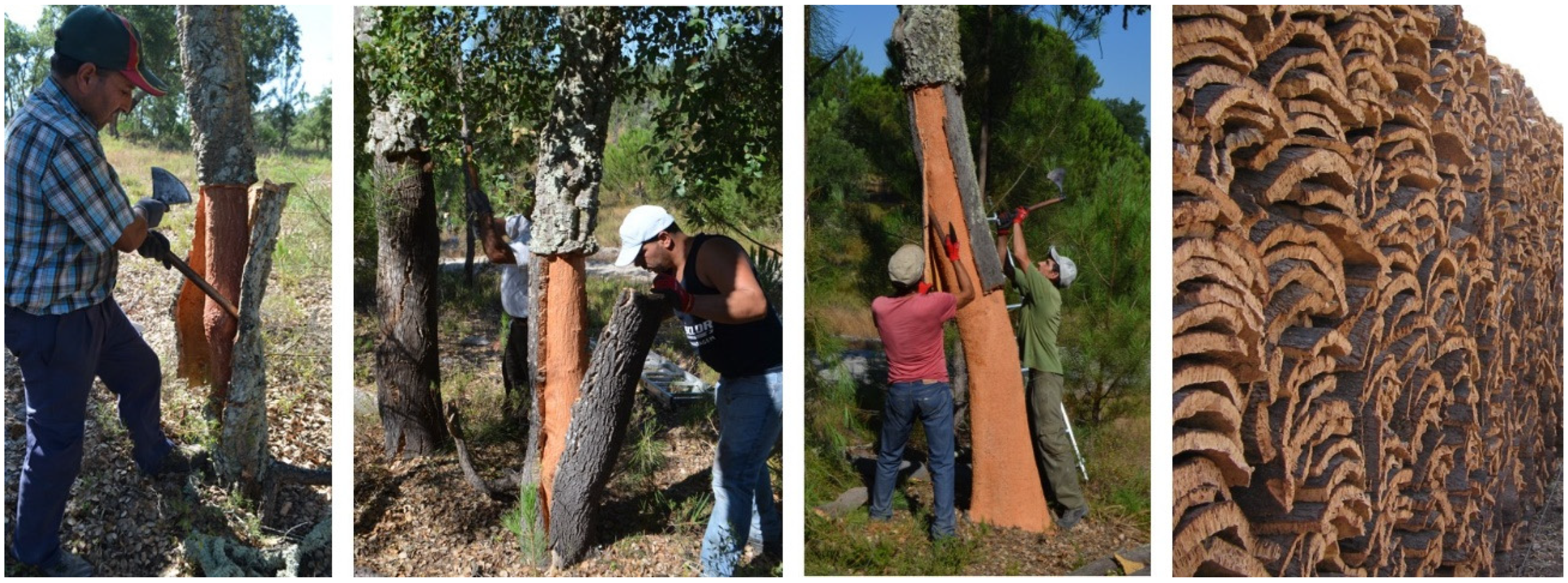
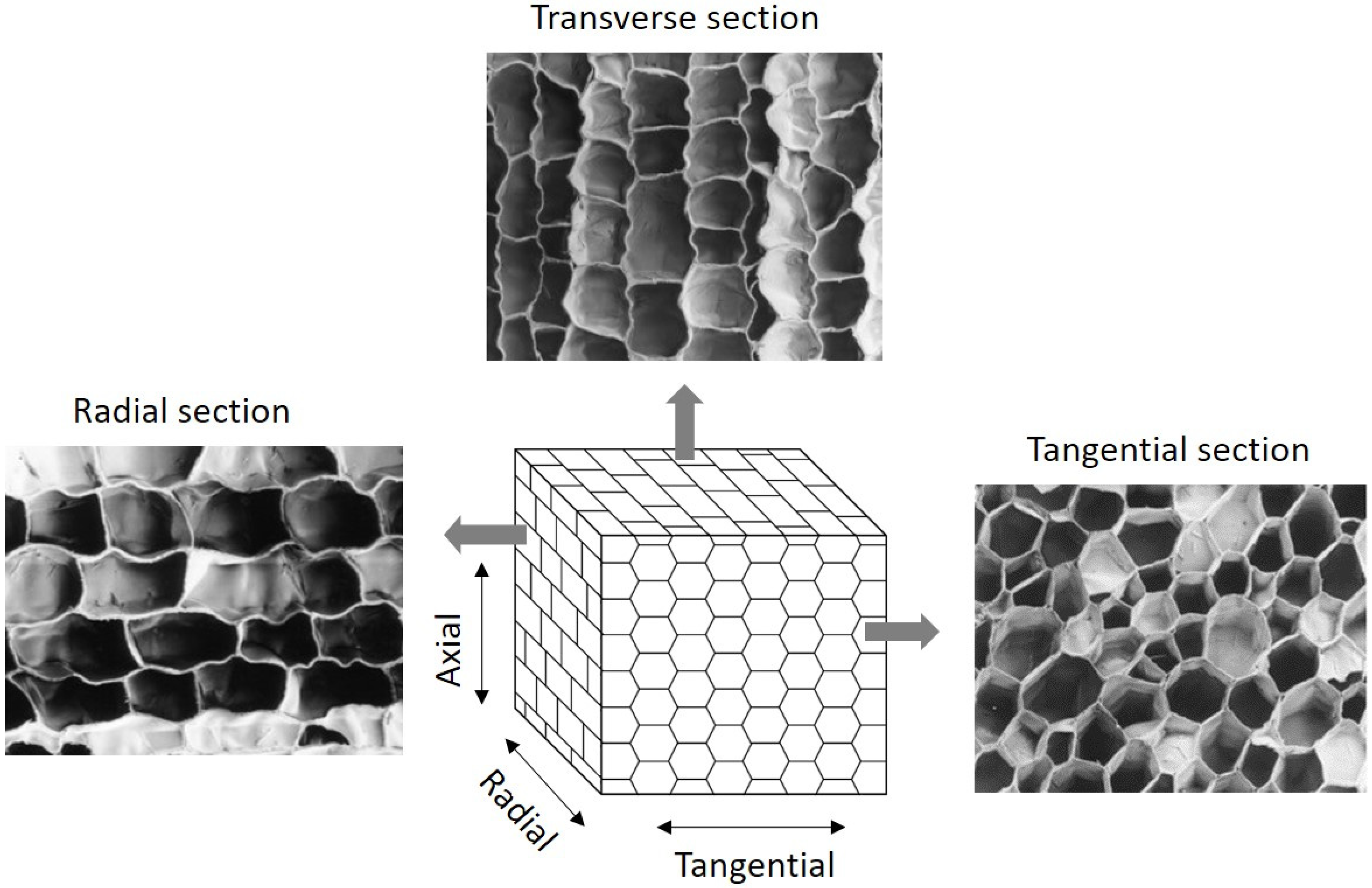

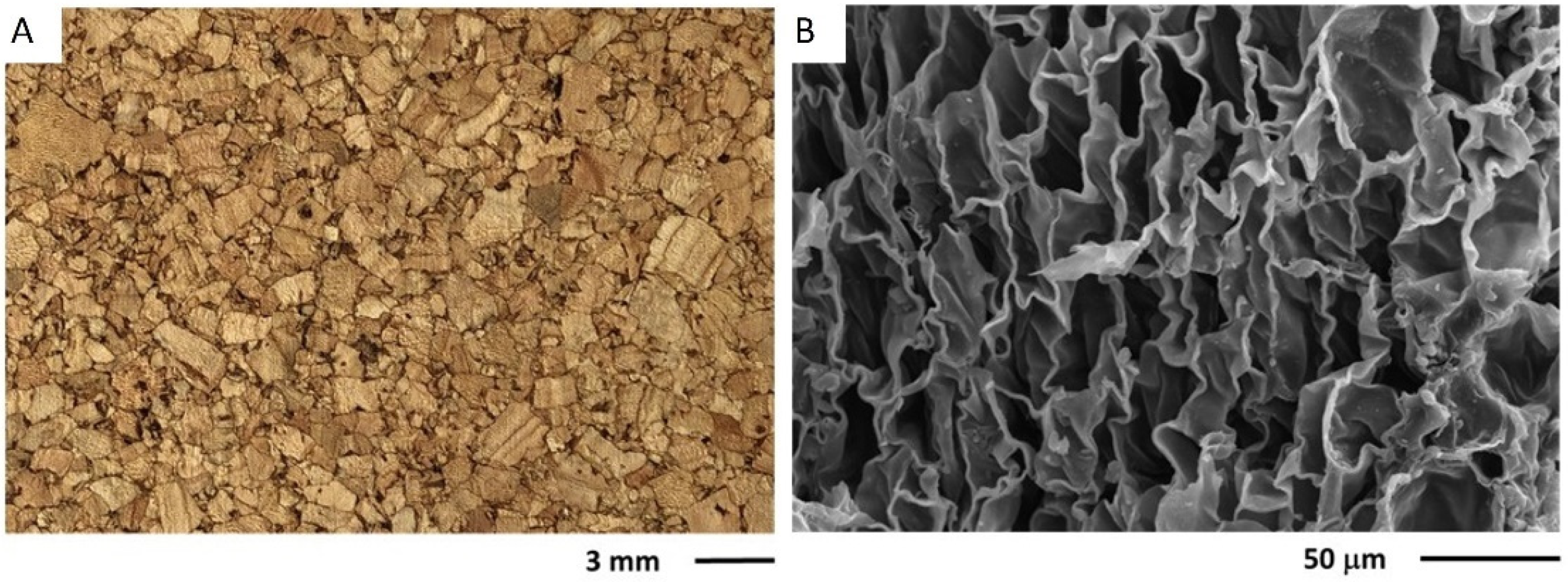
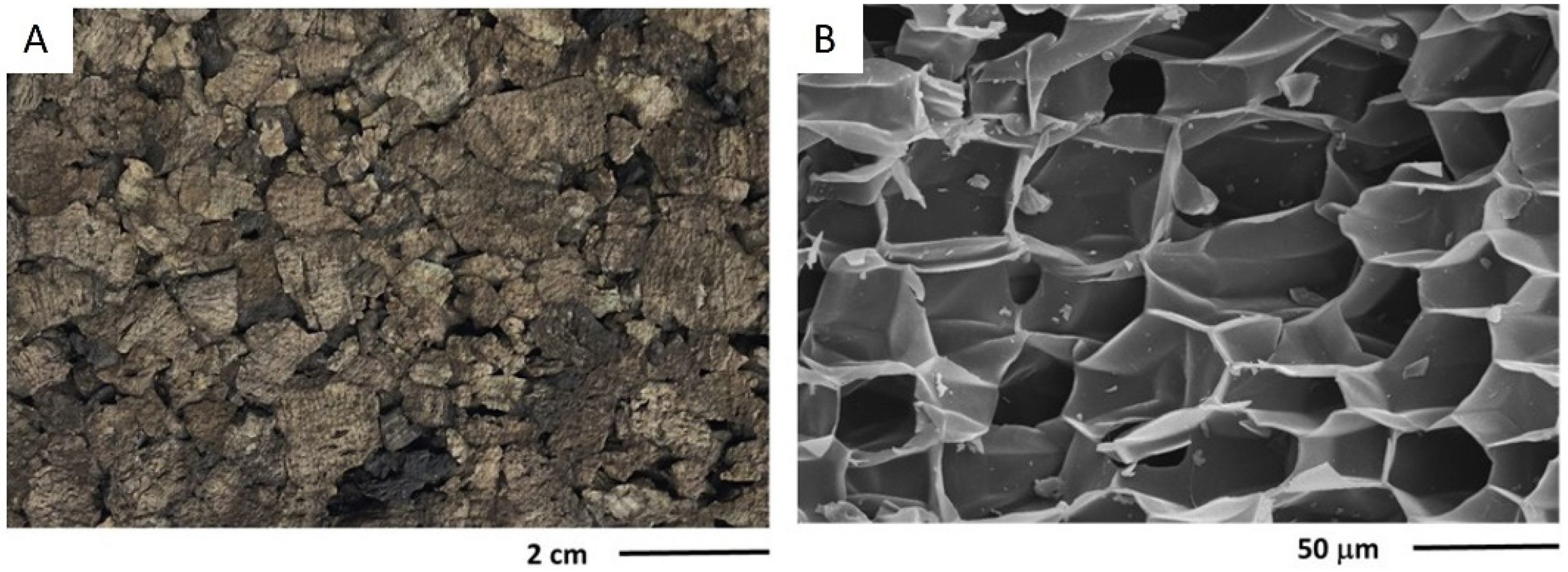

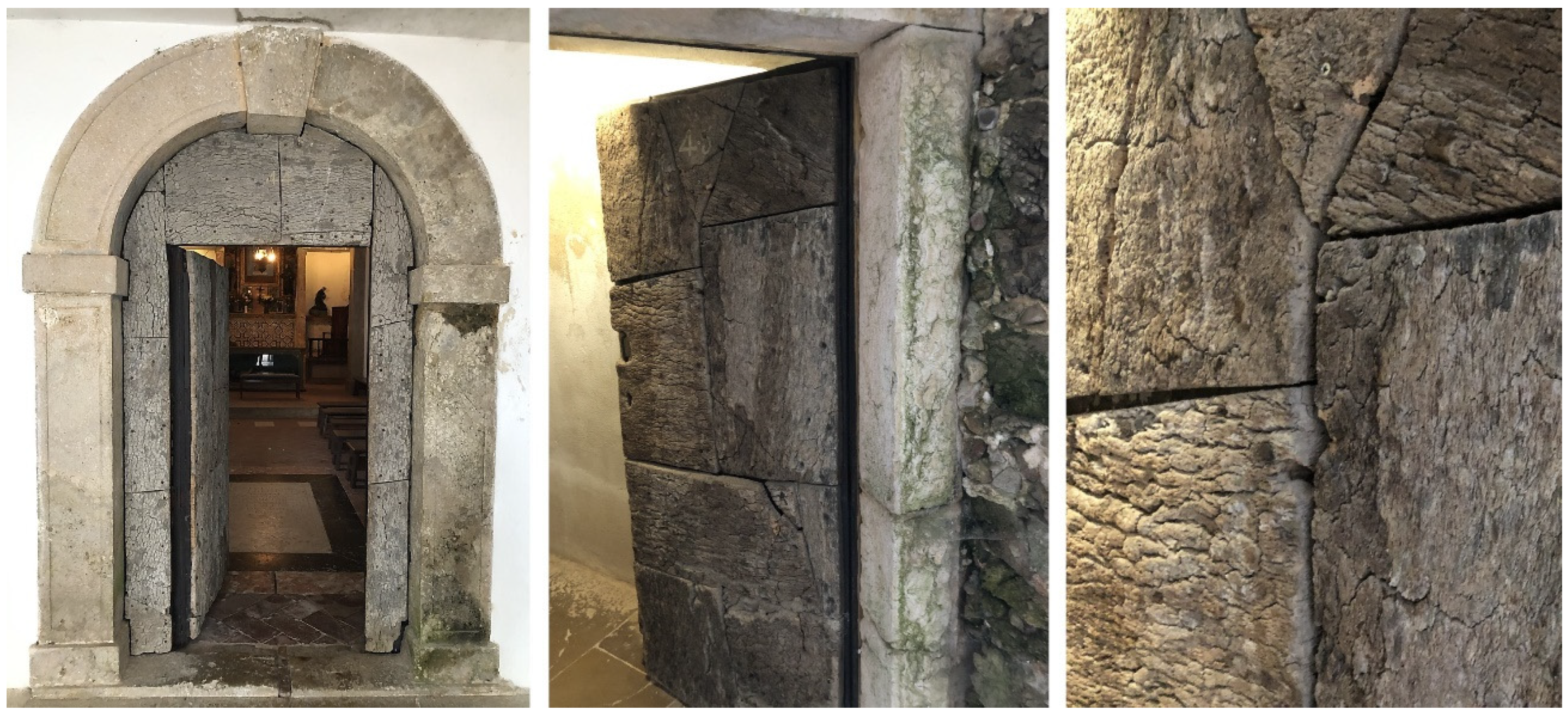
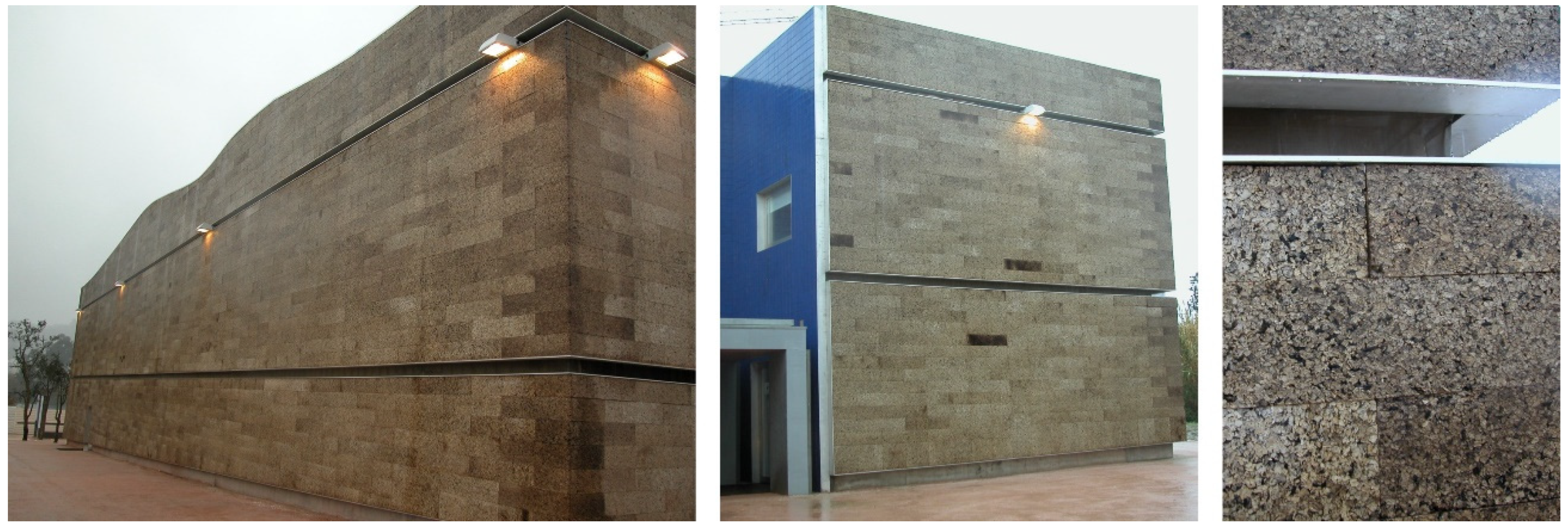
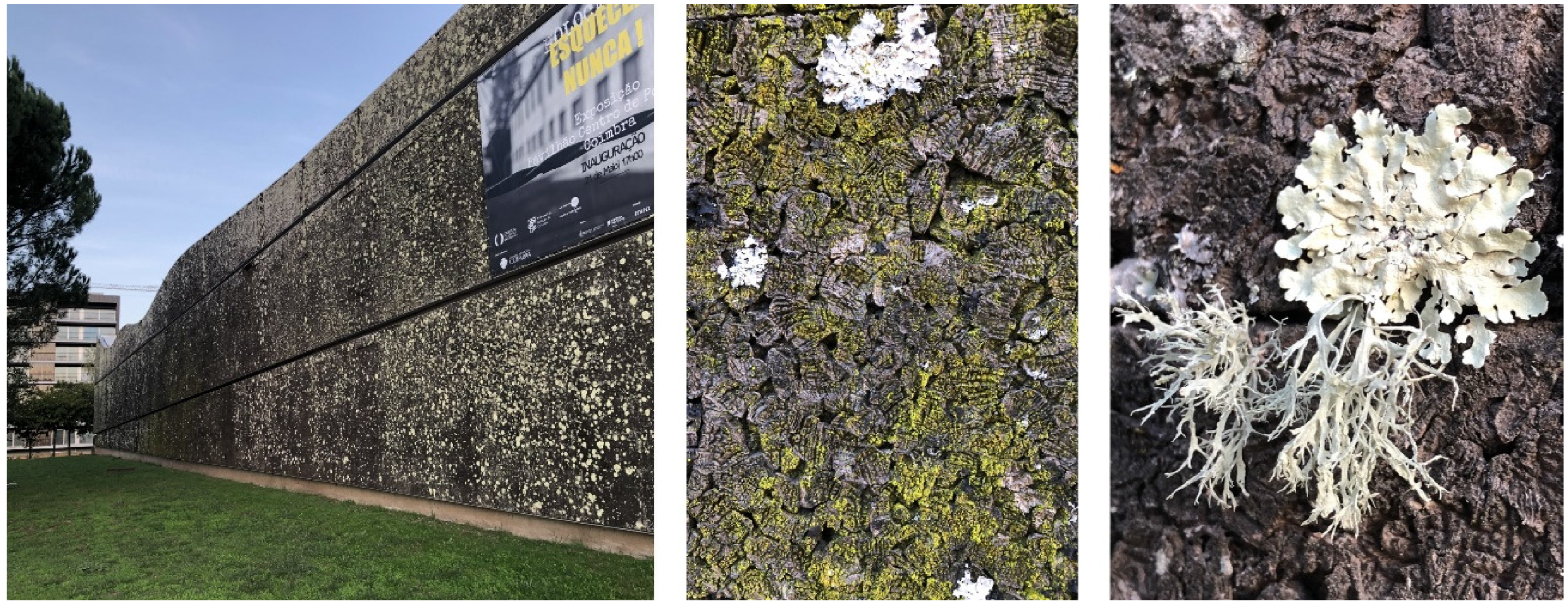
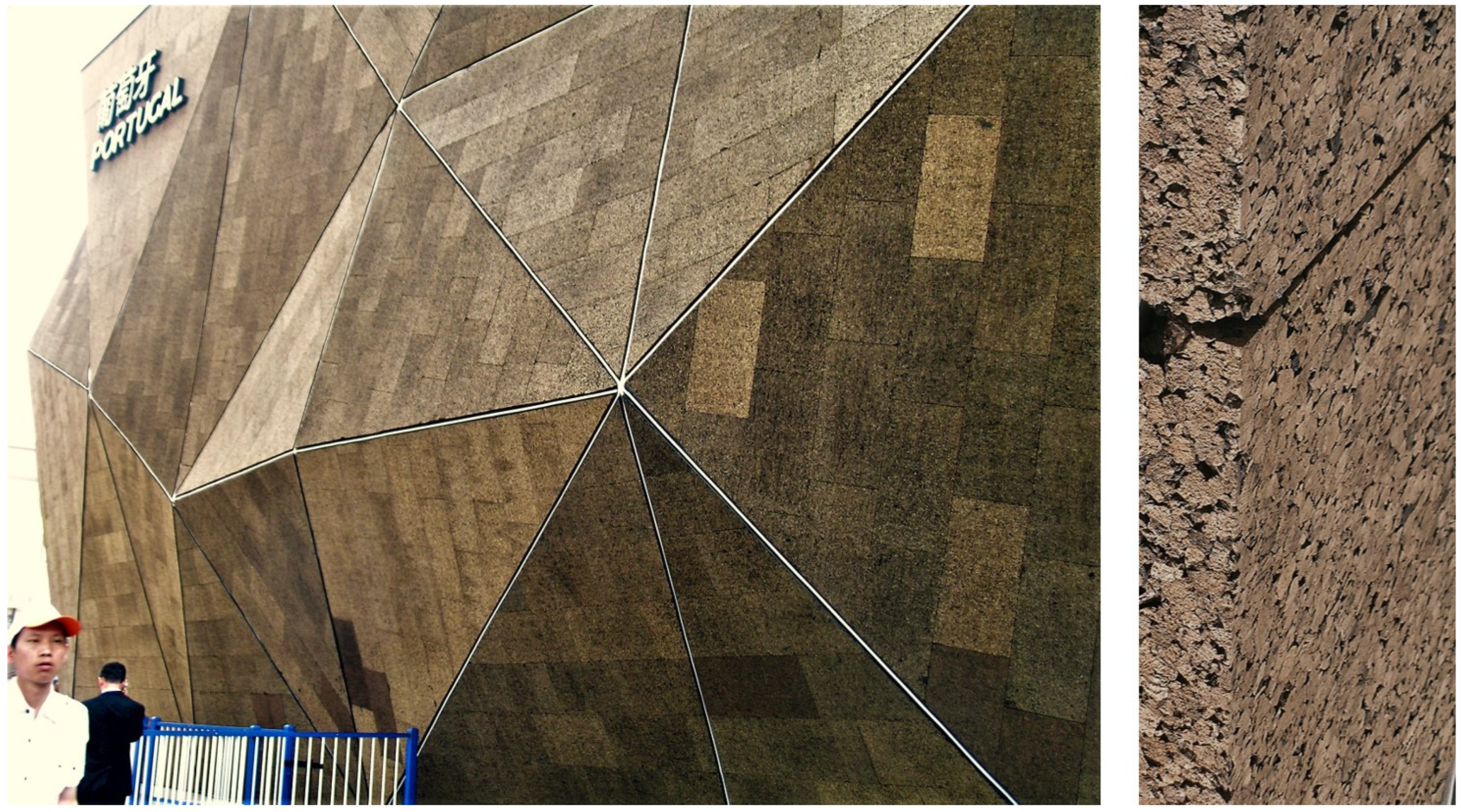

| Property | Value | References |
|---|---|---|
| Thermal conductivity coefficient (θm = 23 °C) dry after one wetting/drying cycle λ(23) | 0.039–0.045 W m−1 K−1 0.041–0.054 W m−1 K−1 0.042–0.056 W m−1 K−1 | [9,32] |
| Specific heat (to 20 °C) | 1.7–1.8 kJ kg−1 K−1 | [32] |
| Thermal expansion coefficient (20 °C) | 40 × 10−6 | [33] |
| Thermal diffusion | 0.18–0.20 × 10−6 m2 s−1 | [32] |
| Water vapour transmission properties vapour transmission rate water vapour permeance water vapour resistance water vapour permeability | 455.54–490.3 mg h−1 m−2 0.33 mg m−2 h−1 Pa−1 3.09 m2 h Pa mg−1 0.01 mg m−1 h−1 Pa−1 | [9,32] |
| Maximum pressure in elastic conditions | 50 kPa | [32] |
| Modulus of elasticity (compression) | 1900–2800 kPa | [32] |
| Modulus of rupture (bending strength) | 140–200 kPa | [9,32] |
| Poisson coefficient | 0–0.02 | [32] |
| Tensile strength perpendicular to faces Dry condition Wet condition (for 28 days) | 67.8–73.2 kPa 64.2–68.8 kPa | [9,32] |
| Dimensional stability length width thickness | 0.3–0.31% 0.3–030% 0.4–0.5% | [9,32] |
| Oxygen index | 26% | [32] |
| Tension deformation at 10% (compression) | 150–180 kPa | [32] |
| Temperature deformation (80 °C) | 1.4 to 2.4% (thickness) | [32] |
| Property | Value | References |
|---|---|---|
| Sound absorption coefficient (500–1500 c/s) | 0.33–0.8 | [32] |
| Thermal conductivity coefficient (θm = 23) dry after one wetting/drying cycle λ(23/50) | 0.037–0.042 W m−1 K−1 0.039–0.044 W m−1 K−1 | [9,32] |
| Water vapour transmission properties vapour transmission rate water vapour permeance water vapour resistance water vapour permeability | 813.64–889.36 mg h−1 m−2 0.58 mg m−2 h−1 Pa−1 1.73 m2 h Pa mg−1 0.04 mg m−1 h−1 Pa−1 | [9,32] |
| Water absorption (immersion) (capillarity) | 9.2% 1.9% | [32] |
| Modulus of rupture (bending strength) | 87.6–160 kPa | [9,32] |
| Tensile strength perpendicular to faces dry condition wet condition (for 7 days) wet condition (for 28 days) | 60.7–69.1 kPa 58.5- 67.1 kPa 44.4–49.0 kPa | [9,32] |
| Compressive stresses at 10% strain Thickness 50 mm Thickness 70 mm | 154–160.1 kPa 131–134 kPa | [9] |
| Shear strength | 55–58 kPa | [9] |
| Compressive force | 0.63–0.76 kPa | [9] |
| Deformation under specified compressive load at 23 ± 5 °C for 48 ± 1 h at 80 ± 1 °C for 48 ± 1 h | 0.302–0.315% 6.844–7.51% | [9] |
| Dimensional variation from 32–66 °C, 90–0% HR | 0.4% | [9,32] |
Disclaimer/Publisher’s Note: The statements, opinions and data contained in all publications are solely those of the individual author(s) and contributor(s) and not of MDPI and/or the editor(s). MDPI and/or the editor(s) disclaim responsibility for any injury to people or property resulting from any ideas, methods, instructions or products referred to in the content. |
© 2024 by the authors. Licensee MDPI, Basel, Switzerland. This article is an open access article distributed under the terms and conditions of the Creative Commons Attribution (CC BY) license (https://creativecommons.org/licenses/by/4.0/).
Share and Cite
Miranda, I.; Pereira, H. Cork Façades as an Innovative and Sustainable Approach in Architecture: A Review of Cork Materials, Properties and Case Studies. Materials 2024, 17, 4414. https://doi.org/10.3390/ma17174414
Miranda I, Pereira H. Cork Façades as an Innovative and Sustainable Approach in Architecture: A Review of Cork Materials, Properties and Case Studies. Materials. 2024; 17(17):4414. https://doi.org/10.3390/ma17174414
Chicago/Turabian StyleMiranda, Isabel, and Helena Pereira. 2024. "Cork Façades as an Innovative and Sustainable Approach in Architecture: A Review of Cork Materials, Properties and Case Studies" Materials 17, no. 17: 4414. https://doi.org/10.3390/ma17174414
APA StyleMiranda, I., & Pereira, H. (2024). Cork Façades as an Innovative and Sustainable Approach in Architecture: A Review of Cork Materials, Properties and Case Studies. Materials, 17(17), 4414. https://doi.org/10.3390/ma17174414








